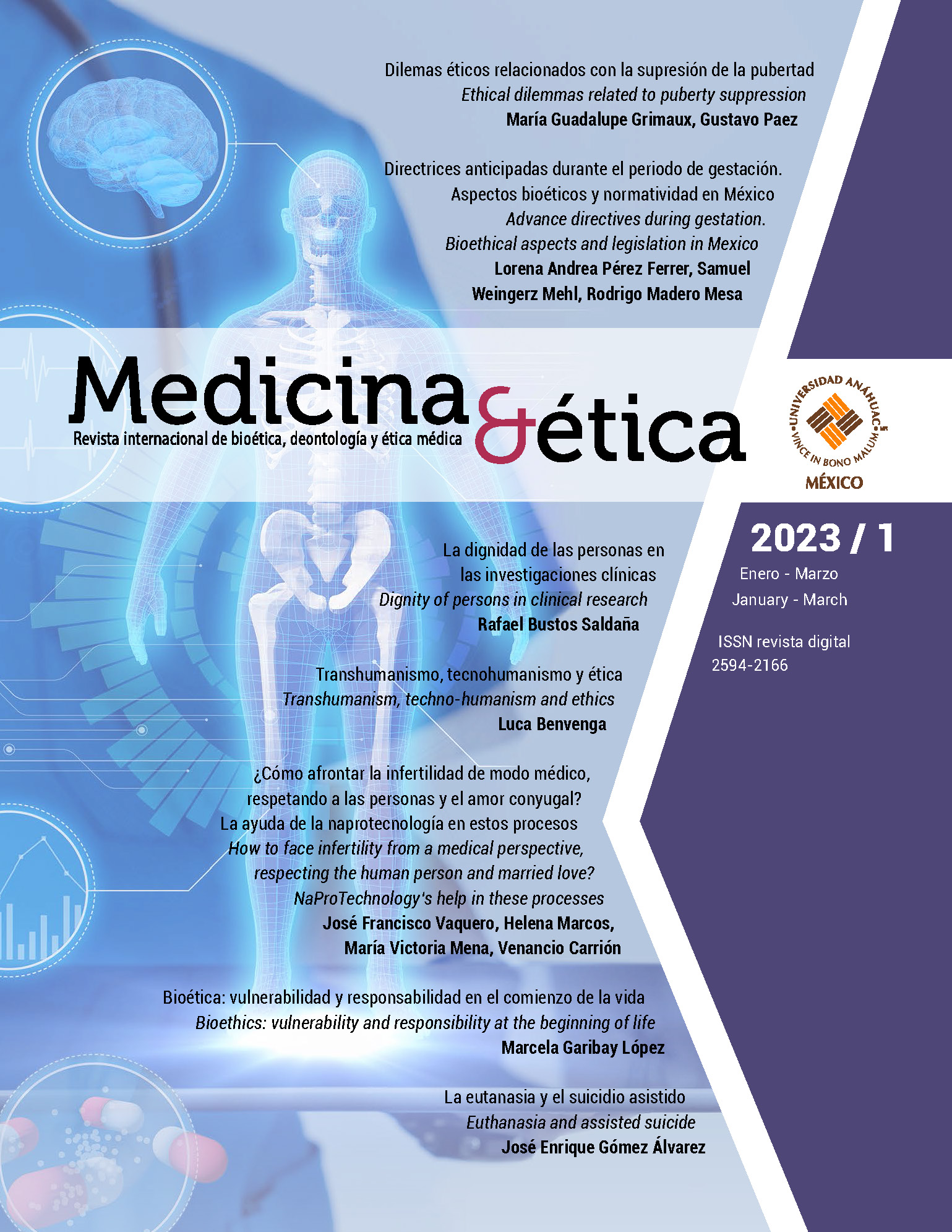How to face infertility from a medical perspective, respecting the human person and married love? NaProTechnology‘s help in these processes
Main Article Content
Abstract
What to do when a married couple wants to have a child and the child is late in coming, or simply does not come? Naprotechnology, as a medical study of male and female fertility, offers a valid answer to face this situation of infertility/sterility.
We follow as a way the triangular method proposed by Elio Sgreccia: look at the scientific data to make an anthropological analysis and an ethical evaluation that guides the concrete action.
Naprotechnology, as a medical science, is a medical and scientific approach that seeks to solve male and female reproductive and gynecological disorders, identifying the main causes that affect true reproductive health. From this diagnosis, it seeks to correct the possible alterations and restore health and fertility. This way of dealing with infertility/sterility is illustrated with several clinical cases and the results obtained in Spain during the years 2015 to 2021.
Next, we carry out an anthropological analysis of the way of dealing with infertility, analyzing the subject who suffers from it: Who is the human being? What is his sexuality like? In what environment is procreation primarily carried out? On this basis, we outline an ethical judgment of this way of dealing with infertility/sterility problems.
Downloads
PLUMX Metrics
Article Details

This work is licensed under a Creative Commons Attribution-NonCommercial-ShareAlike 4.0 International License.
Medicina y Ética is distributed under a Creative Commons License Atribución-NoComercial-CompartirIgual 4.0 Internacional.
The author keeps the property rights with no restriction whatsoever and guarantees the magazine the right to be the first publication of the work. The author is free to deposit the published version in any other medium, such as an institutional archive or on his own website.
References
Eurostat. Total fertility rate [Internet]. Luxemburgo: 2021 [consultado 29 de agosto de 2021]. Disponible en: https://ec.europa.eu/eurostat/databrowser/view/tps00199/default/table?lang=e
Organización de las Naciones Unidas. Infertilidad [Internet]. 2022 [consultado 29 de agosto de 2022]. Disponible en: https://www.who.int/es/health-topics/infertility#-tab=tab_1
García R. Estudio de nuevos marcadores de infertilidad masculina [Tesis de doctorado]. Madrid: Universidad Autónoma de Madrid [Internet]. 2018 [consultado 29 de agosto de 2022]. Disponible en: http://hdl.handle.net/10486/684219
Rodríguez M. Modelo vincular en una pareja tratada a causa de infertilidad. MEDISAN. 2016; 20(10):2294-2297.
Ramírez A, Cala A, Fajardo D, Grave de Peralta R. Factores causales de infertilidad. Rev Información Científica. 2019; 98(2). http://www.revinfcientifica.sld.cu/index.php/ric/article/view/2235
Sgreccia E. Manuale di Bioética. Milano: Vita e Pensiero; 1999.
Stanford J, Smith K, Varner M. Impact of instruction in the Creighton model fertilitycare system on time to pregnancy in couples of proven fecundity: results of a randomised trial: Creighton model and time to pregnancy. Paediatr Perinat Epidemiol. 2014; 28(5):391-9. https://doi.org/10.1111/ppe.12141
Stanford J, Porucznik C. Enrollment, childbearing motivations, and intentions of couples in the Creighton Model Effectiveness, intentions, and Behaviors Assessment (CEIBA) study. Front Med. 2017; 4:147. https://doi.org/10.3389/fmed.2017.00147
Tham E, Schliep K, Stanford J. Natural procreative technology for infertility and recurrent miscarriage: outcomes in a Canadian family practice. Can Fam Physician. 2012; 58(5):e267-74.
Carrión V, Fabrés V. El misterio de la fecundidad en el matrimonio infértil. Hombre y mujer los creó [Internet]. 2019 [consultado 7 de julio de 2019]. Disponible en: https://jp2madrid.es/index.php/aula-abierta/hombre-y-mujer-los-creo/634-hom-muj-19038
Gallo P, Tham J. Medicina y Ética. 2022; 33(1):205. https://doi.org/10.36105/mye.2022v33n1.05
Boyle P, de Groot T, Andralojc K, Parnell T. Healthy singleton pregnancies from restorative reproductive medicine (RRM) after failed IVF. Front Med. 2018; 5:210. https://doi.org/10.3389/fmed.2018.00210
OrganizaciónMundialdelaSalud,Saludsexual[Internet].2022[consultado29de agosto de 2022] Disponible en: https://www.who.int/es/health-topics/sexual-health#tab=tab_2
Valdés, M. Aplicación del conocimiento de la fertilidad humana para buscar embarazo: resultados en el ámbito clínico [Tesis de doctorado]. Madrid: Universidad Rey Juan Carlos. 2012:26-29.
Agarwal A, Majzoub A, Esteves S, Ko E, Ramasamy R, Zini A. Clinical utility of sperm DNA fragmentation testing: practice recommendations based on clinical scenarios. Transl Androl Urol. 2016; 5(6): 935-950.
Hilgers T, Prebil A. The ovulation method: Vulvar observations as an index of ertility/infertility. Obstetrics & Gynecology. 1979; 53(1):12-22.
Hilgers T. The Medical and Surgical Practice of NaProTechnology. Omaha, Nevrasca: Pope Paul VI Institute Press; 2004.
Boyle P, Stanford J. Naprotechnology (natural procreative technology), a multifactorial approach to the chronic problem of infertility. Psu.edu. 2011; 21(3):61-68.
Horodenchuk Z, Furman O, Datsko H. Restorative reproductive medicine for infertility and recurrent miscarriage in the outpatient ob/gyn practice in Ukraine. Kwartalnik Naukowy Fides et Ratio. 2020; 43(3):442-61. https://dspace.vnmu.edu.ua/123456789/5411
Stanford J, Parnell A, Boyle P. Outcomes from treatment of infertility with natural procreative technology in an Irish general practice. Journal of the American Board of Family Medicine: JABFM. 2008; 21(5):375-384. https://doi.org/10.3122/jabfm.2008.05.070239
Vaquero J, Mena M, Marcos H. La ayuda que ofrece la Naprotecnología para afrontar la infertilidad/esterilidad de modo médico y acorde con una sana antropología. Cuad Biot. 2019; 30(100):338. https://doi.org/10.30444/CB.43
Carrión V. La Naprotecnología y más allá. Caminos de esperanza ante la infertilidad. Barcelona: Carena; 2021.
Lucas R. El hombre, espíritu encarnado. Madrid: Atenas; 1993.
Para profundizar en esta cuestión aconsejamos el tratamiento realizado por Lucas R. Antropología y problemas Bioéticos. Madrid: BAC; 2001.
Lucas R. El hombre, espíritu encarnado. Madrid: Atenas; 1993.
Aristóteles, Etica Nicómaco. I(7):1097b-1098a.
Finance J. Etica generale. Bari: Tipografia Medirionale; 1989.
Marqueta J, Hernandez J, Luceño F, Cabell Y, Fernandez Shaw S, Vidal E. Reflexiones en torno a la evolución de la salud reproductiva y de los tratamientos de reproducción asistida en España a la luz del Registro de actividades de la Sociedad Española de Fertilidad. Salud sexual y reproductiva. Aspectos científicos, éticos y jurídicos. Madrid: Comares; 2010.

